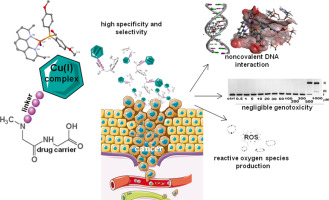当前位置:
X-MOL 学术
›
J. Inorg. Biochem.
›
论文详情
Our official English website, www.x-mol.net, welcomes your
feedback! (Note: you will need to create a separate account there.)
Copper(I) complexes with phosphines P(p-OCH3-Ph)2CH2OH and P(p-OCH3-Ph)2CH2SarGly. Synthesis, multimodal DNA interactions, and prooxidative and in vitro antiproliferative activity.
Journal of Inorganic Biochemistry ( IF 3.8 ) Pub Date : 2019-11-15 , DOI: 10.1016/j.jinorgbio.2019.110926 Urszula K Komarnicka 1 , Sandra Kozieł 1 , Piotr Zabierowski 2 , Rafał Kruszyński 3 , Monika K Lesiów 1 , Francesco Tisato 4 , Marina Porchia 4 , Agnieszka Kyzioł 2
Journal of Inorganic Biochemistry ( IF 3.8 ) Pub Date : 2019-11-15 , DOI: 10.1016/j.jinorgbio.2019.110926 Urszula K Komarnicka 1 , Sandra Kozieł 1 , Piotr Zabierowski 2 , Rafał Kruszyński 3 , Monika K Lesiów 1 , Francesco Tisato 4 , Marina Porchia 4 , Agnieszka Kyzioł 2
Affiliation

|
Phosphonium salt (p-OCH3-Ph)2P(CH2OH)2Cl (MPOHC), derived phosphine ligands without and with SarGly (Sarcosine-Glycine) peptide carrier P(p-OCH3-Ph)2CH2OH (MPOH) and P(p-OCH3-Ph)2CH2SarGly (MPSG), respectively, and two copper(I) complexes [Cu(I)(dmp)(MPOH)] (1-MPOH; dmp = (2,9-dimethyl-1,10-phenanthroline)) and [Cu(I)(dmp)(MPSG)] (1-MPSG) were synthesized. The resulting compounds were characterized by elemental analysis, 1D and 2D NMR and UV-Vis absorption spectroscopies, mass spectrometry, cyclic voltammetry and by X-ray diffraction analysis. Cytotoxicity of all compounds was evaluated in vitro against colon, lung, breast, pancreatic, prostate tumor cell lines, as well as towards non-tumor cell lines: lung, kidney and keratinocyte. Stable in biological medium in the presence of atmospheric oxygen, Cu(I) complexes exerted a cytotoxic effect higher than that elicited by cisplatin against tested cancer cell lines. The introduction of methoxy group onto the phenyl rings of the phosphine ligand coordinated to the copper(I) ion resulted in a relevant increase of cytotoxicity in the case of breast, pancreatic and prostate tumor cell lines in vitro. Attachment of a peptide carrier significantly increased the selectivity towards cancer cells. Fluorescence spectroscopic data (calf thymus DNA: CT-DNA) titration), together with analysis of DNA fragmentation (gel electrophoresis) and molecular docking provided evidence for the multimodal interaction of copper compounds with DNA and showed their unusual low genotoxicity. Additionally, copper complexes were able to generate reactive oxygen species as a result of redox processes, proved by fluorescence spectroscopy and cyclic voltamperometry.
中文翻译:

铜(I)与膦P(p-OCH3-Ph)2CH2OH和P(p-OCH3-Ph)2CH2SarGly的配合物。合成,多峰DNA相互作用以及促氧化和体外抗增殖活性。
磷盐(p-OCH3-Ph)2P(CH2OH)2Cl(MPOHC),衍生的膦配体,不含和带有SarGly(Sarcosine-Glycine)肽载体P(p-OCH3-Ph)2CH2OH(MPOH)和P(p-OCH3 -Ph)2CH2SarGly(MPSG)和两个铜(I)络合物[Cu(I)(dmp)(MPOH)](1-MPOH; dmp =(2,9-二甲基-1,10-菲咯啉))合成了[Cu(I)(dmp)(MPSG)](1-MPSG)。通过元素分析,1D和2D NMR和UV-Vis吸收光谱,质谱,循环伏安法以及X射线衍射分析对所得化合物进行表征。在体外评估了所有化合物对结肠,肺,乳腺,胰腺,前列腺肿瘤细胞系以及对非肿瘤细胞系(肺,肾和角质形成细胞)的细胞毒性。在有氧气存在的生物介质中稳定,Cu(I)复合物对被测癌细胞系的细胞毒性作用高于顺铂引发的细胞毒性作用。在体外对乳腺,胰腺和前列腺肿瘤细胞系的情况下,将甲氧基基团引入与铜(I)离子配位的膦配体的苯环上,导致细胞毒性的相应增加。肽载体的附着显着增加了对癌细胞的选择性。荧光光谱数据(小牛胸腺DNA:CT-DNA)滴定,DNA片段分析(凝胶电泳)和分子对接为铜化合物与DNA的多峰相互作用提供了证据,并显示了其异常低的遗传毒性。此外,由于氧化还原过程,铜络合物能够产生活性氧,
更新日期:2019-11-15
中文翻译:

铜(I)与膦P(p-OCH3-Ph)2CH2OH和P(p-OCH3-Ph)2CH2SarGly的配合物。合成,多峰DNA相互作用以及促氧化和体外抗增殖活性。
磷盐(p-OCH3-Ph)2P(CH2OH)2Cl(MPOHC),衍生的膦配体,不含和带有SarGly(Sarcosine-Glycine)肽载体P(p-OCH3-Ph)2CH2OH(MPOH)和P(p-OCH3 -Ph)2CH2SarGly(MPSG)和两个铜(I)络合物[Cu(I)(dmp)(MPOH)](1-MPOH; dmp =(2,9-二甲基-1,10-菲咯啉))合成了[Cu(I)(dmp)(MPSG)](1-MPSG)。通过元素分析,1D和2D NMR和UV-Vis吸收光谱,质谱,循环伏安法以及X射线衍射分析对所得化合物进行表征。在体外评估了所有化合物对结肠,肺,乳腺,胰腺,前列腺肿瘤细胞系以及对非肿瘤细胞系(肺,肾和角质形成细胞)的细胞毒性。在有氧气存在的生物介质中稳定,Cu(I)复合物对被测癌细胞系的细胞毒性作用高于顺铂引发的细胞毒性作用。在体外对乳腺,胰腺和前列腺肿瘤细胞系的情况下,将甲氧基基团引入与铜(I)离子配位的膦配体的苯环上,导致细胞毒性的相应增加。肽载体的附着显着增加了对癌细胞的选择性。荧光光谱数据(小牛胸腺DNA:CT-DNA)滴定,DNA片段分析(凝胶电泳)和分子对接为铜化合物与DNA的多峰相互作用提供了证据,并显示了其异常低的遗传毒性。此外,由于氧化还原过程,铜络合物能够产生活性氧,











































 京公网安备 11010802027423号
京公网安备 11010802027423号